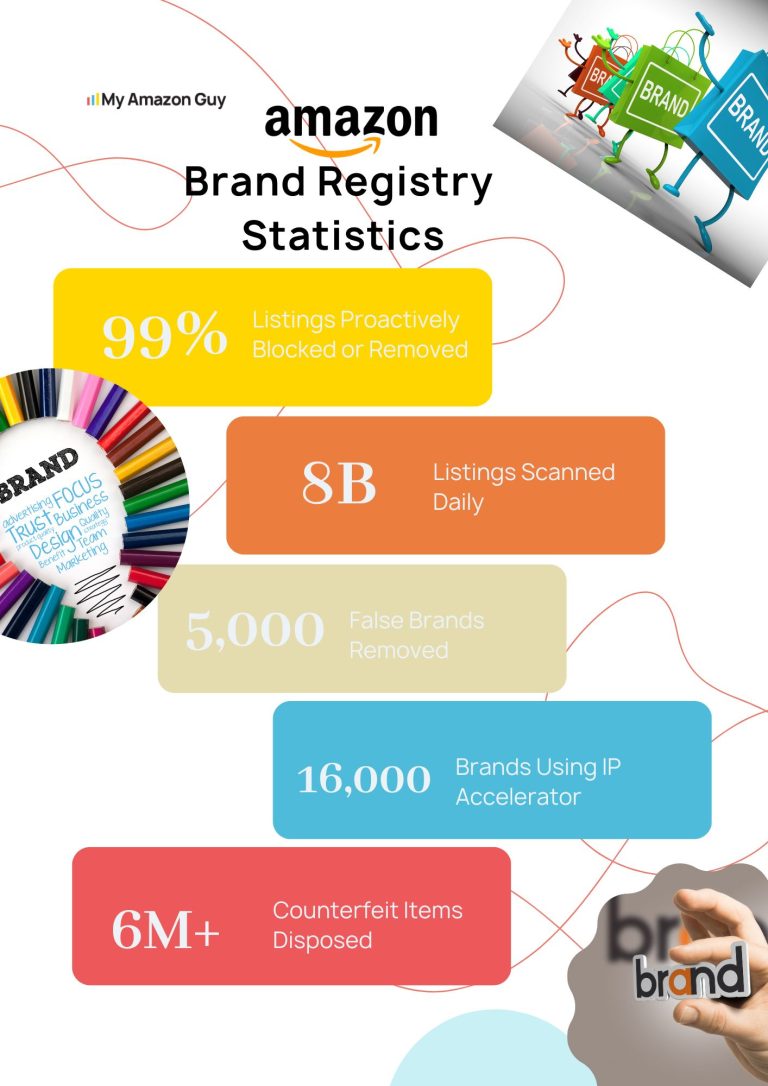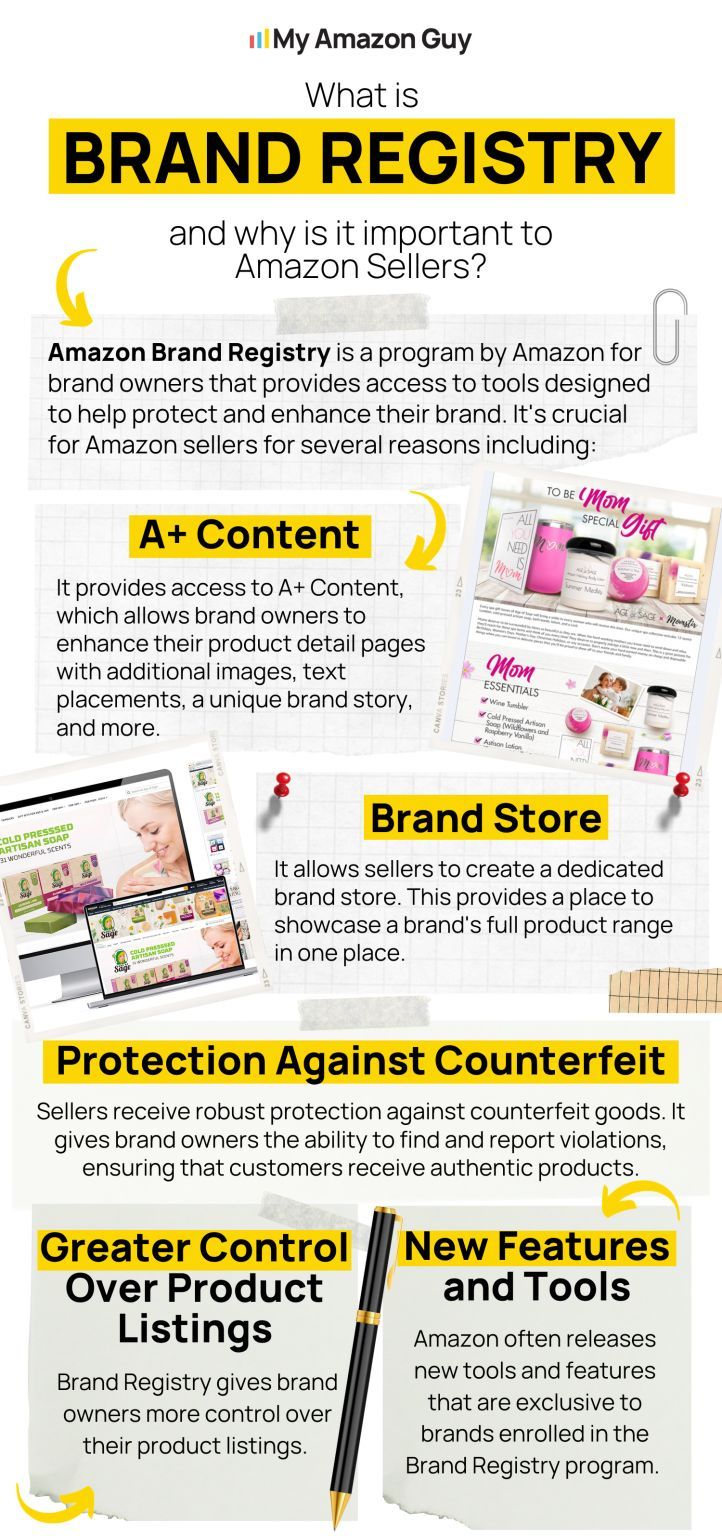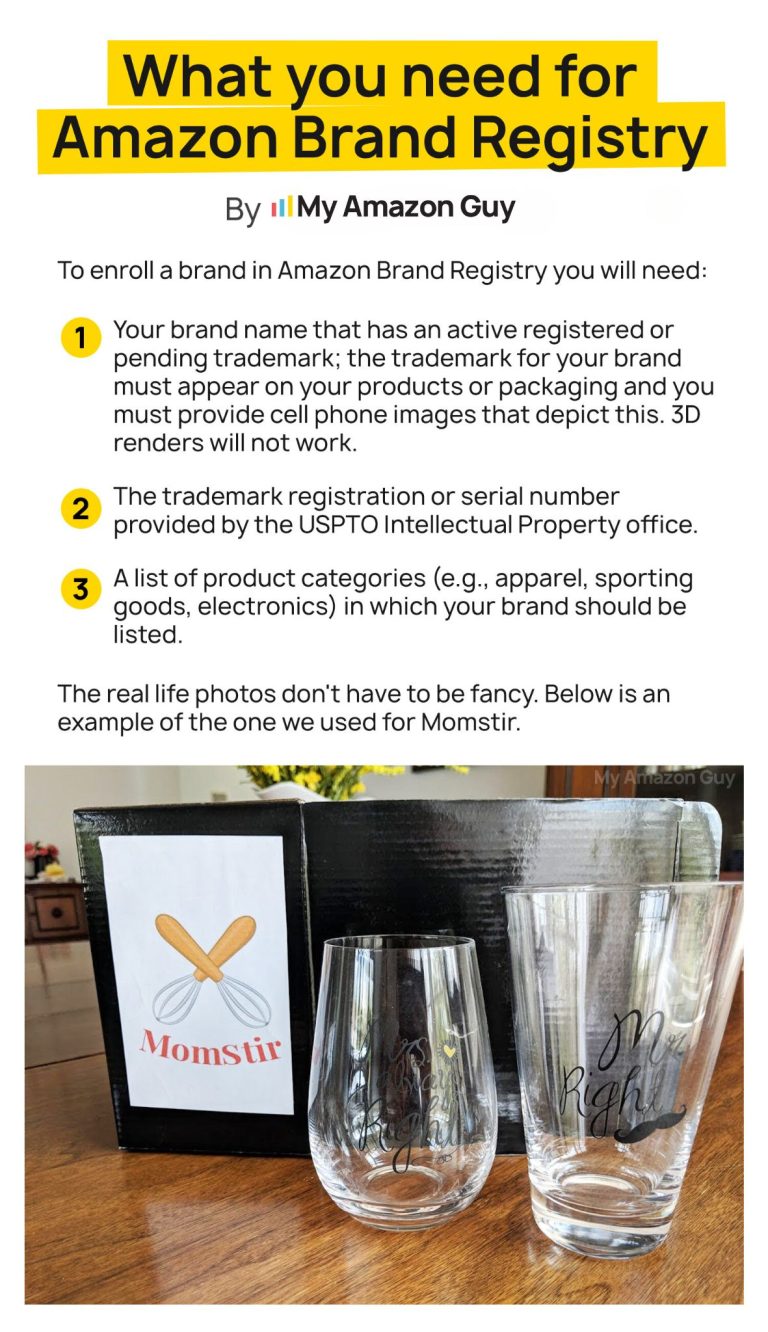In the ever-changing world of Amazon selling, Amazon Brand Registry is a powerful tool that can help you protect and grow your brand. Whether you’re a seasoned seller or just starting out, Brand Registry offers a range of benefits that can give you a competitive edge.
We previously published a 2021 comprehensive guide on brand registry, but it’s time for an update. In our new guide, we’ll cover everything from the benefits of brand registry to the registration process, and we’ll also provide some tips on how to get the most out of brand registry to boost your sales and protect your brand.
Follow our Full Service Amazon Agency for more tips. If you’re interested in asking Amazon Experts for help, our Amazon Agency is ready to serve you.
Here are some figures about Amazon Brand Registry to pique your interest.

What is Brand Registry With Amazon?
Amazon Brand Registry is a global program that helps brands protect their intellectual property (IP) on Amazon. When you enroll in Brand Registry, you gain access to a suite of tools that allow you to:
- Easily manage your brand’s product listings
- Find and report IP violations
- Prevent non-authentication
These tools can help you protect your brand from counterfeiters, improve your visibility on Amazon, and provide a better shopping experience for your customers.
How do I know if I have a brand registry on Amazon?
To determine if you have a brand registry on Amazon, you can follow these steps:
- Log in to your Amazon Seller Central account.
- Go to the “Brands” tab in the navigation menu.
- If you have brand registry, you should see your brand(s) listed in this section.
- Click on the brand name to access the brand-specific details and settings.
- Look for any brand registry-related features, such as enhanced brand content (EBC) options or tools for brand protection.
How long does brand registry last?
Brand registry on Amazon does not have a specific expiration date. Once your brand is successfully registered, it remains in the registry indefinitely, as long as you maintain eligibility requirements and comply with Amazon’s policies.
However, it is important to note that Amazon may periodically review and update its brand registry program, so it’s a good practice to stay informed about any changes or updates that may affect your brand registration status.

Will I Benefit From Amazon Brand Registry?
What advantages does Brand Registry provide for sellers?
There are several benefits that sellers can get from Amazon Brand Registry, such as:
Brand Protection
Brand Registry helps protect your intellectual property rights by giving you more control over your brand and product listings. It allows you to report and remove counterfeit or infringing listings more effectively.
Brand Protection Programs for brand-registered sellers include:
- Transparency – Brand Registry enrollees have the option to participate in the Amazon Transparency program. This program provides unique codes for each unit of your products, which customers can scan to verify the authenticity of the product, ensuring a higher level of trust and reducing the risk of counterfeits.
- Project Zero – Amazon Project Zero is a program that gives brands the ability to remove counterfeit listings from Amazon’s marketplace quickly and easily. Brands that enroll in Project Zero must provide Amazon with certain information about their products, such as their brand name, logo, and UPC codes.
Amazon then uses this information to create a “fingerprint” for each of the brand’s products.
- Counterfeit Crimes Unit – Amazon’s Counterfeit Crimes Unit (CCU) is a team of experts who work to combat counterfeiting on Amazon’s marketplace. The CCU uses a variety of methods to identify and remove counterfeit listings, including machine learning, human review, and partnerships with brands, law enforcement, and other organizations.
The CCU has been very successful in reducing the number of counterfeit listings on Amazon’s marketplace, and is committed to protecting customers from counterfeit products and ensuring that only genuine products are sold on the platform.
Brand Building
Brand Building Programs for brand-registered sellers include:
- A+ Content
- Sponsored Brands
- Stores
- Vine
- Customer Engagement
- Video Shopping – Product Videos
- Amazon Live
- Subscribe and SSave
- Virtual Bundles
How does it help to prevent unauthorized sellers from selling my products?
Brand registry helps prevent unauthorized sellers from selling your products on Amazon in several ways:
- Brand Gating: With brand registry, you have the ability to set up brand gating, which restricts who can sell your products on the Amazon marketplace. Brand gating allows you to control which sellers are authorized to list and sell your products, helping to prevent unauthorized sellers from hijacking your listings.
- Enhanced Brand Content (EBC): Brand registry allows you to create Enhanced Brand Content (EBC) or A+ Content for your product listings. By leveraging EBC, you can create compelling product descriptions, images, and videos that can help differentiate your brand and products. This can deter unauthorized sellers from attempting to list counterfeit or unauthorized versions of your products.
- Transparency Program: Brand registry enrollees have the option to participate in the Amazon Transparency program. This program allows you to apply unique codes to each unit of your products, which can be scanned by customers to verify the authenticity of the product. This helps deter unauthorized sellers from listing counterfeit versions of your products.
- Brand Protection Tools: Brand registry provides access to powerful brand protection tools, such as the ability to report and remove counterfeit or infringing listings. By actively monitoring and taking action against unauthorized sellers, you can maintain control over your brand and product listings on Amazon.
Does Brand Registry help with improving product visibility and sales?
Yes, Brand Registry can help improve product visibility and sales on Amazon. Here’s how:
- Enhanced Brand Content (EBC): Brand Registry provides access to Enhanced Brand Content (EBC) or A+ Content. This allows you to create visually appealing and informative product descriptions with additional images, videos, and enhanced formatting. EBC helps capture shoppers’ attention, highlight product features, and provide a better shopping experience, which can ultimately lead to increased sales.
- Brand Store: With Brand Registry, you can create a customized brand store on Amazon. This storefront allows you to showcase all your products in a visually appealing and cohesive manner. It helps create a branded shopping experience for customers and increases brand visibility, potentially leading to higher sales.
- Brand Analytics: Registered brand owners gain access to brand analytics, which provide insights into customer search terms, conversion rates, and other performance metrics. This data can help you make data-driven decisions to optimize your product listings, marketing strategies, and inventory planning, ultimately driving sales growth.
- Brand Protection: By enrolling in Brand Registry, you gain additional control over your brand and product listings, which helps protect your brand’s reputation. This can instill trust in customers and increase the likelihood of them choosing your products over competitors, leading to higher sales.
Am I eligible for Amazon Brand Registry?
What are the requirements for brand eligibility?
Having any of these can make you eligible to enroll in Brand Registry:

Do you need a trademark for Amazon?
Yes, having a registered trademark is generally required for certain programs and services on Amazon, such as Brand Registry. Brand Registry allows brand owners to protect their intellectual property, gain additional control over their product listings, and access various brand-building tools and features on the platform.
To enroll in Amazon’s Brand Registry program, you typically need an active registered trademark for your brand. This means you must have a valid trademark registered with the appropriate intellectual property office in the country where you want to enroll your brand.
Having a registered trademark provides evidence of your brand’s ownership and helps establish your rights to the brand name, logo, or other intellectual property associated with your products. It adds an extra layer of protection against counterfeiters and unauthorized sellers, as well as strengthens your brand’s presence and credibility on the Amazon marketplace.
However, it’s important to note that while a registered trademark is generally required for Brand Registry, it may not be mandatory for selling products on Amazon in general. You can still list products without a trademark, but you may not have access to all the brand protection and brand-building features available through Brand Registry. It’s always recommended to consult with a legal professional or Amazon expert for specific guidance on trademark requirements and intellectual property protection on the platform.
Are there any restrictions on the types of brands that can be registered?
Amazon’s Brand Registry program generally accepts a wide range of brands, but there are some restrictions and guidelines to consider. Some of the key factors to keep in mind include:
- Intellectual Property Rights: To be eligible for Brand Registry, you must have intellectual property rights associated with your brand, such as trademarks, copyrights, or patents. These rights help establish your ownership of the brand and provide the basis for protecting your intellectual property on Amazon.
- Active Registered Trademark: You typically need to have an active registered trademark for your brand to enroll in Brand Registry. This means you must have a valid trademark registered with the relevant intellectual property office in the country where you wish to enroll your brand.
- Principal Brand Owner: You must be the brand owner or an authorized agent of the brand to enroll in Brand Registry. This means you should have the legal rights and authority to represent and protect the brand’s intellectual property.
- Accurate Product Listings: Your product listings on Amazon must accurately represent your brand and its products. This includes using correct product images, descriptions, and other relevant information that aligns with your brand’s identity.
While these are general considerations, it’s important to note that specific requirements and restrictions may vary based on the country and program. It’s always advisable to review Amazon’s official guidelines and requirements for Brand Registry to ensure that your brand meets the necessary criteria before applying.
How Do I Complete Amazon Brand Registration Process?
How do I access the Brand Registry section in Seller Central?
To access the Brand Registry section in Seller Central, you can follow these steps:
- Log in to your Seller Central account on Amazon.
- Go to the “Advertising” tab in the top navigation menu.
- From the dropdown menu, select “Brand Registry”.
- You may be prompted to enter your Brand Registry login credentials or verify your identity.
- Once you have successfully logged in to Brand Registry, you will be able to access the various tools and features available for brand protection, brand building, and managing your brand presence on Amazon.
An alternative way to enroll in Amazon Brand Registry is to visit this link.
What information do I need to provide during the enrollment process?
During the enrollment process for Amazon’s Brand Registry, you will typically need to provide the following information:
- Brand Name: You will need to provide the name of your brand as it appears on your registered trademark.
- Registered Trademark Information: You will need to provide details about your registered trademark, including the trademark registration number, the country or region in which it was registered, and the intellectual property office where it was registered.
- Government-Registered Intellectual Property (IP) Rights: You may need to provide additional information about your intellectual property rights, such as copyright or patent information, if applicable.
- Brand Owner Information: You will need to provide information about the brand owner, including the legal name, address, and contact information.
- Authorized Agent Information (if applicable): If you are not the brand owner but an authorized agent applying on their behalf, you may need to provide your own information as the authorized agent.
- Product Categories: You will need to specify the product categories that your brand operates in.
- Images and Documentation: You may be required to submit images of your brand logo, packaging, or other supporting documentation to verify the authenticity and ownership of your brand.
Watch these videos below to learn about Amazon Brand Registry
How long does it take to get brand registered on Amazon?
The time it takes to get brand registered on Amazon can vary. The process typically involves submitting an application and providing the necessary information and documentation to prove your ownership of the brand and its associated intellectual property.
Once you have submitted your application, it may take several weeks to several months to receive a decision from Amazon regarding your brand registration. The exact timeframe can depend on various factors, including the volume of applications being processed, the completeness and accuracy of the information provided, and any additional verification or documentation that may be required.
It’s important to note that the brand registration process can sometimes involve back-and-forth communication with Amazon’s Brand Registry team, especially if additional information or clarification is needed. Therefore, it’s advisable to ensure that you have all the required information and documentation ready and provide clear and accurate details to help expedite the process.
While there is no fixed timeframe for brand registration on Amazon, it’s recommended to monitor your application status regularly and follow up with Amazon’s Brand Registry support if needed.
Are There Fees Associated With Amazon Brand Registry?
How much does it cost for brand registry on Amazon?
The cost for brand registry on Amazon is typically free. There is no direct fee charged by Amazon for enrolling in the Brand Registry program. However, it’s important to note that there may be costs associated with obtaining and maintaining the necessary intellectual property rights for your brand, such as registering a trademark with the appropriate intellectual property office.
Trademark registration fees can vary depending on the country and the specific requirements of the intellectual property office. These fees are separate from any charges imposed by Amazon and are typically paid directly to the intellectual property office.
It’s also worth mentioning that certain optional services or programs within Brand Registry, such as Enhanced Brand Content or Sponsored Brands advertising, may have associated costs. These additional services and features are not mandatory for brand registry but can provide additional benefits and opportunities for brand owners on the Amazon platform.
It’s always advisable to review Amazon’s official documentation and guidelines for Brand Registry to understand any potential costs or fees associated with specific services or programs. Additionally, consulting with a legal professional or Amazon expert can provide further guidance on the costs involved in obtaining and maintaining the necessary intellectual property rights for your brand.
Can I Gauge How Amazon Brand Registry Works?
How can I track the performance of my brand on Amazon?
Are there any specific metrics or analytics provided for registered brands?
Yes, Amazon provides specific metrics and analytics for registered brands through the Amazon Brand Analytics tool. This tool offers valuable insights into your brand’s performance on Amazon. Here are some of the metrics and analytics available:
- Search Frequency Rank: This metric shows how often your brand’s products appear in customer searches compared to other brands in the same product category. It can help you understand the popularity and visibility of your brand on Amazon.
- Market Basket Analysis: Market basket analysis provides information on the frequently co-purchased products with your brand’s products. This can help you identify cross-selling opportunities and understand customer purchase behavior.
- Competitor ASINs: You can access information on the top ASINs (Amazon Standard Identification Numbers) that customers view alongside your brand’s ASINs. This insight can help you identify competitors and understand customer preferences and buying patterns.
- Item Comparison and Alternate Purchase Behavior: This metric shows the ASINs that customers view and purchase instead of your brand’s ASINs. It helps you identify potential competitors and areas where you can improve your product offerings or marketing strategies.
- Demographics: Amazon Brand Analytics provides demographic data on customers who view and purchase your brand’s products. This includes information on age, gender, household income, and more. Understanding your target audience demographics can help you tailor your marketing and advertising strategies.
It’s important to note that access to Amazon Brand Analytics is currently available for brands registered in the United States, United Kingdom, Germany, France, Italy, Spain, India, and Japan.
These metrics and analytics can provide valuable insights into your brand’s performance and customer behavior on Amazon, allowing you to make data-driven decisions and optimize your strategies.
What To Do After Brand Registry on Amazon?
After successfully enrolling in Amazon Brand Registry, there are several actions you can take to maximize the benefits and protect your brand on Amazon. Here are some key steps to consider:
- Monitor Your Brand: With Brand Registry, you gain access to tools and features that help you monitor your brand’s presence on Amazon. Regularly review your brand’s product listings, customer reviews, and seller performance to identify any potential infringements or unauthorized activity.
- Report Violations: If you come across any instances of counterfeit products, trademark infringements, or unauthorized sellers using your brand, utilize the “Report a Violation” tool provided through Brand Registry. Report such violations to Amazon and take appropriate actions to protect your brand’s integrity.
- Enhance Product Listings: Leverage the Enhanced Brand Content (EBC) feature available through Brand Registry to create more compelling and informative product listings. EBC allows you to include enhanced images, detailed product descriptions, and additional brand content to attract and engage customers.
- Utilize Brand Store: Take advantage of the Brand Store feature to create a customized storefront on Amazon. This allows you to showcase your brand’s products, tell your brand story, and provide a seamless shopping experience for customers.
- Protect Your Intellectual Property: Enrolling in Brand Registry strengthens your ability to protect your intellectual property rights on Amazon. Consider registering your trademarks in relevant countries and enforcing your rights against any unauthorized use or infringement.
- Monitor Competitors: Keep an eye on your competitors’ activities. Monitor their product listings, pricing strategies, and customer reviews to stay informed about market trends and maintain a competitive edge.
- Optimize Advertising Campaigns: If you are running advertising campaigns on Amazon, regularly analyze and optimize your campaigns based on performance data. This can help you drive more targeted traffic to your product listings and boost sales.
How can I contact Amazon's support team for Brand Registry-related issues?
There are a few ways to contact Amazon’s support team for Brand Registry-related issues:
- Through Seller Central: If you are a seller on Amazon, you can contact the Brand Registry team through Seller Central. To do this, go to Seller Central and click on the “Help” menu. Then, select “Contact Us” and choose the “Brand Registry” option.
- Through the Amazon Brand Registry website: You can also contact the Brand Registry team through the Amazon Brand Registry website. To do this, go to the Amazon Brand Registry website and click on the “Contact Us” link.
- By phone: You can also call the Amazon Brand Registry team by phone. Amazon’s customer service phone number is 1-888-280-4331.
Is Brand Registry available in all Amazon marketplaces worldwide?
Amazon currently only accepts trademarks issued by government offices in the following countries:
- United States
- Brazil
- Canada
- Mexico
- Australia
- India
- Japan
- France
- Germany
- Italy
- Turkey
- Singapore
- Spain
- Saudi Arabia
- United Kingdom
- Egypt
- Sweden
- Poland
- Benelux
- European Union
- United Arab Emirates
Are there any country-specific requirements or considerations for brand registration?
Yes, there can be country-specific requirements and considerations for brand registration on Amazon. While the general process of registering a brand on Amazon’s Brand Registry may be similar across marketplaces, there may be specific requirements and guidelines that vary by country. Here are some country-specific considerations you may need to be aware of:
- United States (US): In the US, brand owners are required to have a registered trademark with the United States Patent and Trademark Office (USPTO) to enroll in Brand Registry. The trademark must be in the form of a word mark, design mark, or a combination of both.
- Europe (EU): In the European Union, brand owners can provide either a registered trademark with the European Union Intellectual Property Office (EUIPO) or a national trademark from one of the EU member states to enroll in Brand Registry.
- China: In China, brand owners must have a registered trademark with the China National Intellectual Property Administration (CNIPA) to enroll in Brand Registry.
- Other International Marketplaces: Different marketplaces may have their own specific requirements for brand registration. It is advisable to review the guidelines and eligibility criteria provided by each marketplace to ensure compliance with their specific requirements.
Can I use the same brand registration for multiple marketplaces?
Yes, in most cases, you can use the same brand registration for multiple marketplaces on Amazon. Once you have successfully registered your brand on Amazon’s Brand Registry in one marketplace, such as the United States or Europe, you can usually leverage that registration to gain brand protection and benefits in other marketplaces as well.
Amazon’s Brand Registry program is designed to provide brand owners with global brand protection. While there may be some country-specific requirements for brand registration, the overall goal of Brand Registry is to help brand owners protect their intellectual property rights across different Amazon marketplaces.
It’s important to note that while the brand registration itself can be used across marketplaces, you may still need to follow specific guidelines and requirements for each individual marketplace. This may include providing additional documentation or complying with specific marketplace policies. It’s advisable to review the guidelines and requirements of each marketplace where you plan to expand your brand presence to ensure compliance and maximize the benefits of Brand Registry in each location.
What Problems Are Usually Encountered By Sellers When Enrolling In Amazon Brand Registry?
When enrolling in Brand Registry, sellers may encounter several common problems. Here are a few examples:
- Trademark Registration Rejection: If your trademark application is rejected, you need to review the rejection reasons provided by the intellectual property office and make the necessary amendments or arguments to address the issues.
- Trademark Infringement Claims: If another brand accuses you of trademark infringement, it’s crucial to gather evidence to defend your case. Consult with a legal professional experienced in intellectual property law to assess your situation and guide you through the process.
- Brand Hijacking: Unauthorized sellers may try to list counterfeit or infringing products under your brand. Monitor your brand’s listings regularly, report any violations to Amazon, and consider using brand protection services to proactively identify and remove unauthorized sellers.
- Difficulty Linking Products: Sometimes, sellers face challenges when trying to link their products to their brand registry. Ensure that you have accurate and complete product information, including UPC/EAN/ISBN codes, and follow Amazon’s guidelines for linking products to your brand.
- Restricted Categories: Certain categories on Amazon may have additional requirements for brand registration. If you encounter restrictions, review the specific category requirements and ensure that you meet them before attempting to enroll in the Brand Registry.
- Multiple Brand Owners: If your brand has multiple owners or is part of a larger entity, you may face complications during the brand registry process. Consult with a legal professional to determine the best approach for registering your brand in such cases.
- Trademark Expiration: Trademarks have an expiration date, and if your trademark expires, it can affect your eligibility for the Brand Registry. Ensure that you renew your trademark in a timely manner to maintain your eligibility.
- Incomplete Documentation: When enrolling in the Brand Registry, you may need to provide certain documents, such as proof of trademark registration. Make sure you have all the required documentation ready and submit it accurately to avoid delays or rejections.
- Brand Name or Logo Changes: If you make changes to your brand name or logo after enrolling in the Brand Registry, you need to update your trademark registration accordingly. Failure to do so may result in complications or loss of brand registry benefits.
- Lack of Understanding or Guidance: Understanding the intricacies of brand registry and trademark regulations can be challenging. Consider consulting with experts, such as intellectual property attorneys or experienced Amazon consultants, who can provide guidance and help you navigate through any issues that arise.
Watch these videos to know more about Amazon Brand Registry-related issues.
Conclusion
Enrolling in Amazon Brand Registry can be beneficial for sellers as it provides enhanced brand protection, access to features like Enhanced Brand Content and Sponsored Brand Ads, valuable insights through Brand Analytics, and the ability to create a customized Brand Store.
These benefits can help sellers protect their brand, improve product listings, drive traffic and sales, and create a cohesive brand presence on the Amazon platform.
However, the value of Brand Registry may vary depending on individual business goals and resources.
It is important for sellers to carefully evaluate their brand’s needs and strategies to determine if enrolling in Brand Registry aligns with their objectives.






